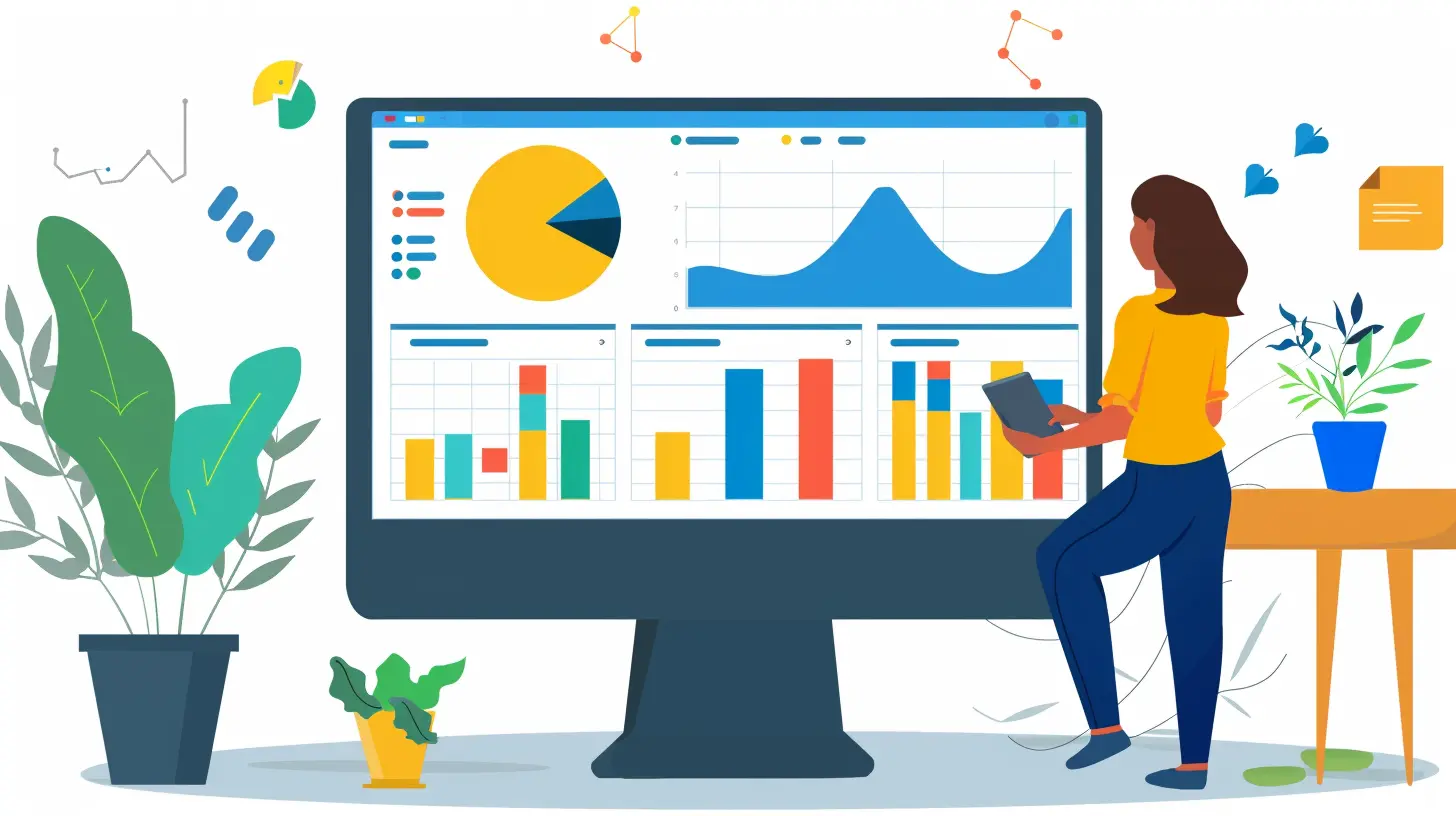Improving Your Email Marketing ROI With Smart Analytics
6 May 2025
Ah, email marketing — the unsung hero of digital marketing. Sure, social media is flashy, and PPC ads have their shiny allure, but there’s something about email marketing that just works. It’s like that dependable friend who shows up with coffee when you’re having a rough week.
But let’s be honest: not all email campaigns are created equal. Some emails bring in a flood of clicks, conversions, and happy subscribers, while others…well, let’s just say they’re where good intentions go to die (a.k.a. the spam folder).
So, how do you make sure your email strategy isn’t just a shot in the dark? Enter smart analytics! If data is the new oil, smart analytics is the refinery that transforms raw numbers into insights. Let’s break this down, step by step, so you can whip your email marketing ROI into shape like a pro.
Why Email Marketing Still Reigns Supreme
Before we dive into analytics, let’s appreciate why email marketing is worth the fuss. Did you know that for every $1 spent on email marketing, the average ROI is a whopping $36? That’s better than most stocks, real estate investments, or even your cousin’s “genius” crypto picks.Email gives you a direct line to your audience. No algorithms deciding who sees your content. No distractions from funny cat videos. Just you and your subscriber, having a one-on-one convo in their inbox. But—and it’s a big but—the inbox is a crowded place. You need to stand out. 
So, What’s the Deal With “Smart Analytics”?
Alright, let’s talk about the star of the show: smart analytics. Think of it as your trusty sidekick that helps you figure out what’s working, what’s not, and where you’re wasting precious time (and money).Smart analytics combines data collection, processing, and actionable insights to help you make informed decisions. It’s not about staring at rows of numbers and pretending you know what “click-to-open rate” means. No, it’s about using tools and techniques to actually do something with the data. 
The Holy Grail Metrics for Email Success
You can’t improve what you don’t measure, right? Here are the key metrics that your smart analytics toolkit should focus on:1. Open Rates
This is your first big clue. Are people even bothering to open your emails? If your open rates are tanking, either your subject lines are snoozefests, or your timing is way off.Pro Tip: Test out different subject lines and use A/B testing like a boss. Try injecting humor, curiosity, or personalization (e.g., “Hey [First Name], You’ll LOVE This!”).
2. Click-Through Rates (CTR)
So they opened your email—great! But did they click on anything? CTR tells you how engaging your content is and whether your call-to-action (CTA) is actually, you know, doing its job.Ask yourself: Is my CTA clear and enticing? If your CTA reads like, “Click here to learn more,” it’s about as exciting as a Monday morning.
3. Conversion Rates
This is the money shot! Conversions measure how many people actually took the desired action, whether that’s making a purchase, signing up for a webinar, or downloading your e-book.If your conversions are low, something’s breaking down in your email journey. Use analytics to pinpoint where the drop-off happens.
4. Bounce Rates
Yikes—emails that bounce back are wasted opportunities. High bounce rates could mean your email list is outdated, or (ouch) people gave you fake emails on purpose.Keep that list clean, folks! Analytics tools can help you identify and remove the dead weight.
5. Unsubscribe Rates
No one likes a breakup email, but unsubscribes happen. The key is to use this metric as a learning tool. If unsubscribes spike after a certain type of email, it’s time to rethink your approach.
How Smart Analytics Boosts ROI
So, how exactly does smart analytics help you squeeze more bang for your buck? Here’s the inside scoop:1. Hyper-Personalization
You know what people love? Feeling special (just like that extra slice of pizza at dinner). Smart analytics allows you to segment your audience and send hyper-personalized emails.For example, analytics can show you who’s opening your emails at 8 AM vs. 8 PM, so you can time your campaigns perfectly. It’s like being in the right place at the right time—every single time.
2. Predictive Insights
What if you could predict which customers are most likely to buy? With analytics, you can identify patterns in past behavior. If someone clicks on your product links three times in a row but hasn’t purchased yet, you know they’re on the fence. That’s your cue to send a targeted follow-up email.3. Content Optimization
Let’s say your audience loves product demos but couldn’t care less about behind-the-scenes company updates. Analytics will point that out loud and clear. You can then focus on creating content your subscribers actually want to see.It’s like offering chocolate cake to a chocoholic—instant win.
4. Reduced Customer Acquisition Costs
By using analytics to target your most engaged subscribers, you save money. Why? Because you’re not wasting resources on people who couldn’t care less about your brand.Smart Tools to Supercharge Your Analytics Game
Now, I know what you’re thinking: “Okay, this all sounds great, but how do I actually do it?” Good question. The answer lies in your choice of analytics tools. Here are a few that’ll make your life a whole lot easier:1. Google Analytics
Don’t underestimate this classic. Google Analytics can track email campaigns when integrated with UTM parameters. It’s like a GPS for your email links.2. HubSpot Email Marketing
If you want an all-in-one solution, HubSpot is a crowd favorite. It tracks everything from open rates to revenue attribution.3. Mailchimp
Mailchimp’s analytics are as user-friendly as they come. Plus, their heat maps make it easy to see which parts of your email are getting the most attention.4. Litmus
This tool is perfect for testing and tracking. Litmus lets you preview your emails across devices and analyze performance post-send.Common Email Analytics Mistakes to Avoid
Even with the smartest tools, mistakes happen. Here are some common pitfalls and how to dodge them:1. Focusing on Vanity Metrics
Sure, high open rates feel great, but they’re just the tip of the iceberg. Dig deeper into CTRs, conversions, and long-term engagement.2. Ignoring Mobile Optimization
Fun fact: Over 50% of emails are opened on mobile devices. If your emails aren’t optimized for tiny screens, you’re leaving money on the table.3. Sending Too Many or Too Few Emails
Underwhelming your audience is as bad as overwhelming them. Use analytics to find the Goldilocks Zone—not too many, not too few.4. Not Testing Enough
If you’re not A/B testing different subject lines, layouts, and CTAs, you’re missing out on opportunities to improve. Testing is your best friend.Wrapping It All Up
If email marketing is a game, smart analytics is your cheat code for leveling up. By tracking the right metrics, leveraging the right tools, and avoiding common mistakes, you can transform your campaigns from “meh” to money-making machines.Remember, it’s not about sending more emails. It’s about sending better emails—the kind that your subscribers actually want to read, click, and act on. So, go on and give smart analytics a shot. Your ROI will thank you.
all images in this post were generated using AI tools
Category:
Email MarketingAuthor:

Lily Pacheco
Discussion
rate this article
7 comments
Caroline Edwards
Leveraging smart analytics in email marketing not only enhances campaign performance but also empowers businesses to make data-driven decisions, ultimately maximizing ROI and fostering deeper customer engagement.
May 17, 2025 at 10:22 AM

Lily Pacheco
Thank you for your insightful comment! Absolutely, smart analytics is key to driving improved ROI and deeper engagement in email marketing.
Georgina Romero
This article highlights the critical role of analytics in optimizing email marketing strategies. By leveraging data-driven insights, businesses can significantly enhance their ROI. I appreciate the practical tips provided, which encourage marketers to make informed decisions and continuously refine their approach for better results.
May 16, 2025 at 6:45 PM

Lily Pacheco
Thank you for your thoughtful comment! I'm glad you found the insights and tips valuable for enhancing email marketing ROI. Your feedback is much appreciated!
Elora Morgan
Email marketing and analytics are like peanut butter and jelly—together, they create deliciously profitable sandwiches! Let’s spread the jam of data insights for a ROI feast that leaves everyone craving more!
May 14, 2025 at 7:12 PM

Lily Pacheco
Absolutely! Combining email marketing with strong analytics is key to maximizing ROI and creating impactful results. Let’s keep serving up those insights!
Zevon McLoughlin
While leveraging smart analytics in email marketing can enhance ROI, it's crucial to balance data-driven decisions with creativity. Over-reliance on metrics may stifle innovative approaches that truly engage your audience.
May 14, 2025 at 3:09 AM

Lily Pacheco
I completely agree! Balancing data-driven insights with creative strategies is essential for truly engaging your audience and maximizing ROI in email marketing.
Petra Fletcher
This article sparks great curiosity! I'm eager to learn how smart analytics can transform email marketing efforts and boost ROI. Excited to explore innovative strategies and real-world applications!
May 11, 2025 at 12:49 PM

Lily Pacheco
Thank you for your enthusiasm! I'm excited for you to explore how smart analytics can optimize your email marketing strategies and enhance ROI. Stay tuned for innovative insights!
Ashley Fletcher
Great insights! Utilizing smart analytics is essential for enhancing email marketing ROI. Thank you for sharing!
May 8, 2025 at 9:05 PM

Lily Pacheco
Thank you for your feedback! I'm glad you found the insights valuable. Happy marketing!
Flora McElhinney
Great insights! I'm eager to implement these strategies for better email marketing results.
May 7, 2025 at 4:46 AM

Lily Pacheco
Thank you! I'm glad you found the insights helpful. Best of luck with your email marketing efforts!
MORE POSTS

Creating an Effective HR Crisis Management Plan for Unexpected Events

The Ethical Boundaries of Competitive Analysis

How Cross-Functional Teams Can Enhance Operational Efficiency

Rethinking the Annual Performance Review: Is it Obsolete?

The Power of Minimalism in Email Design

The Impact of Outsourcing on Business Agility